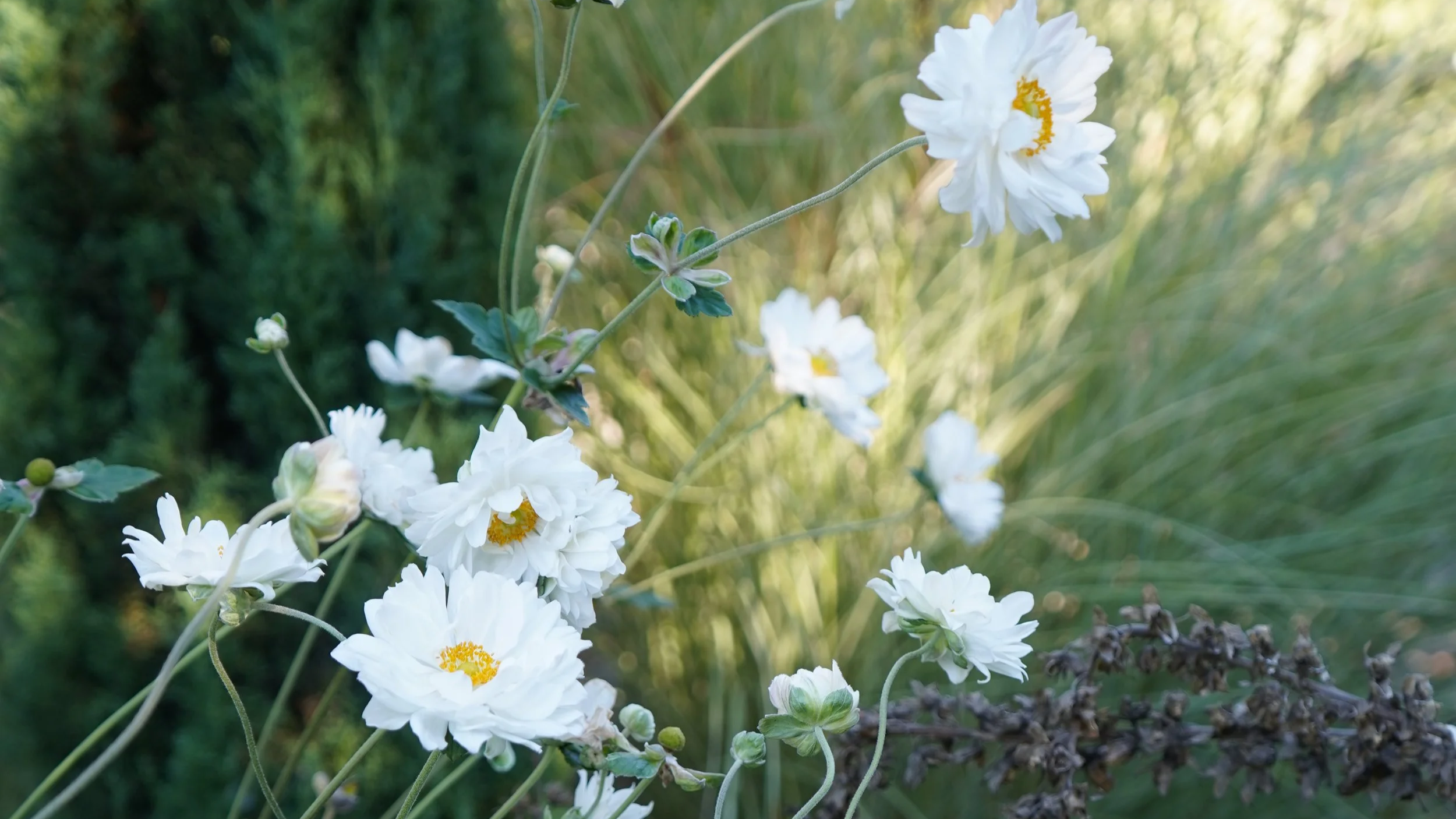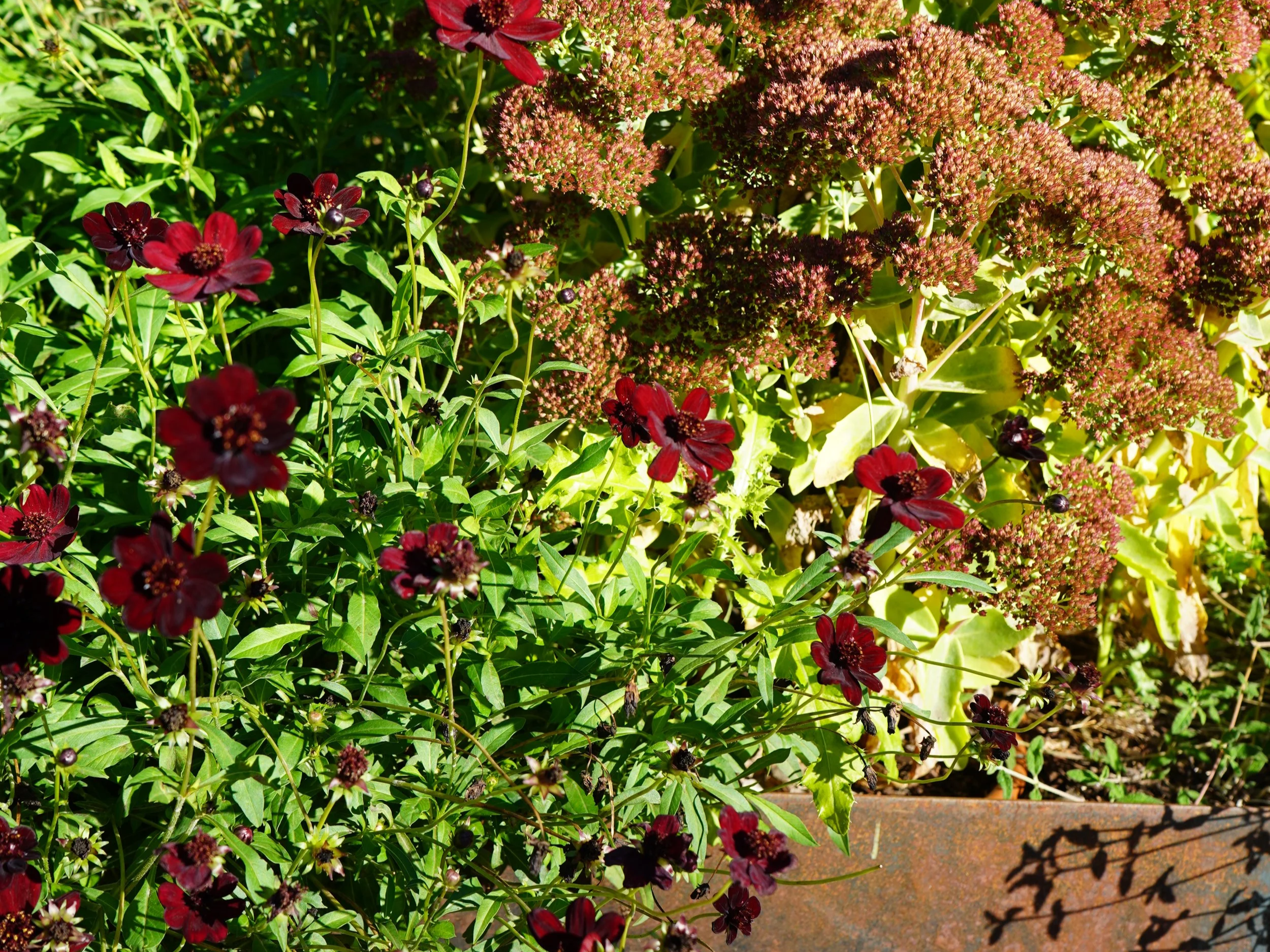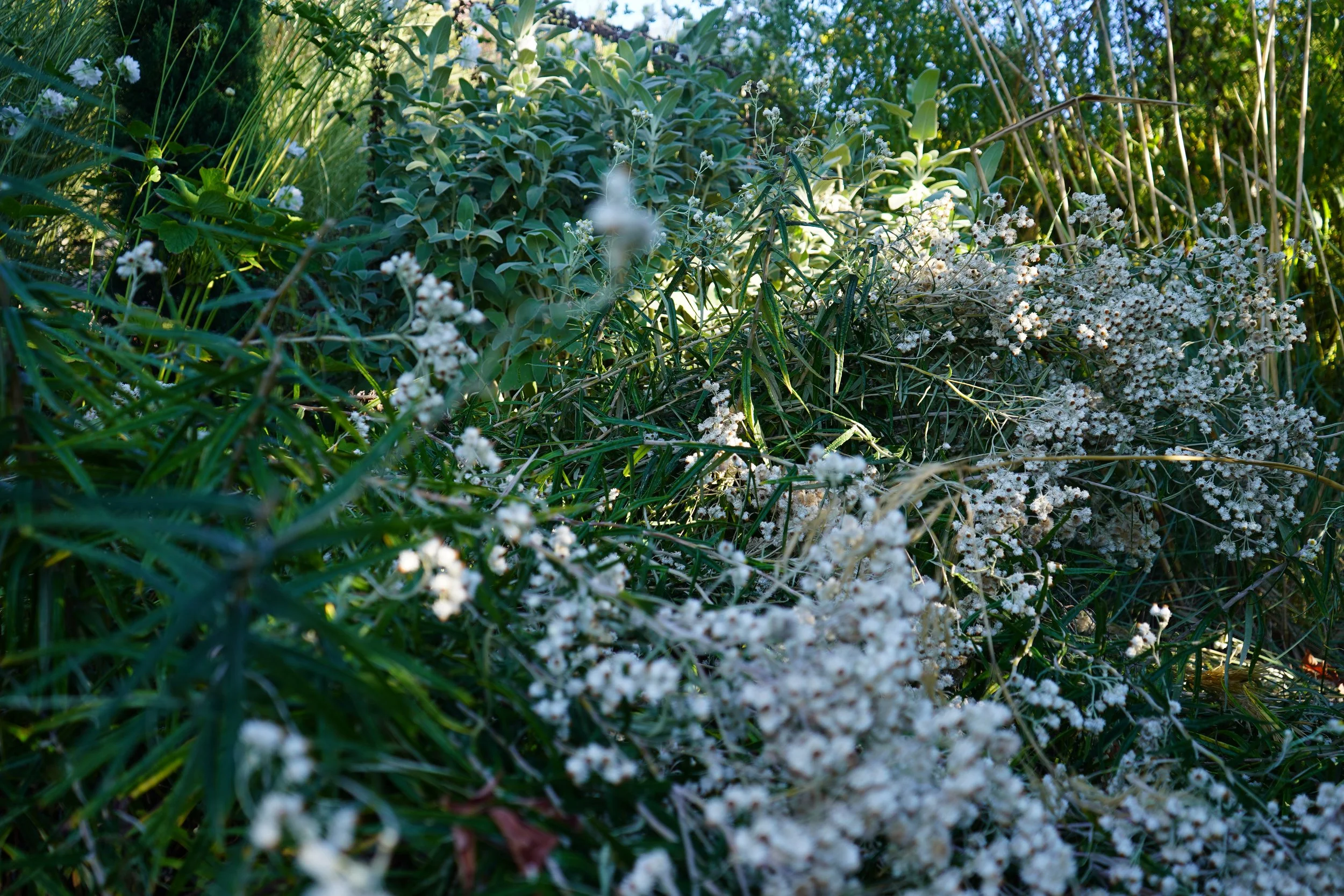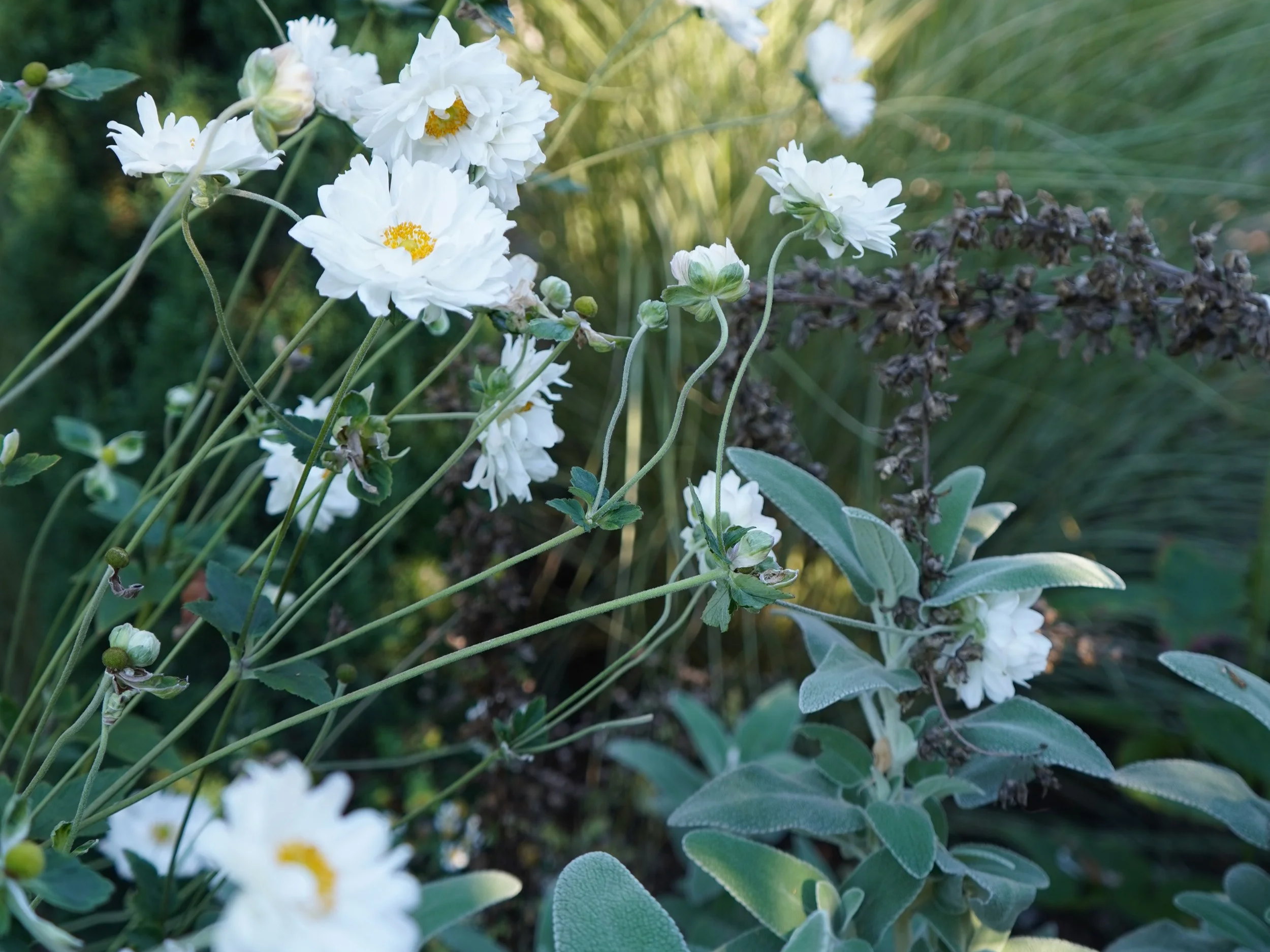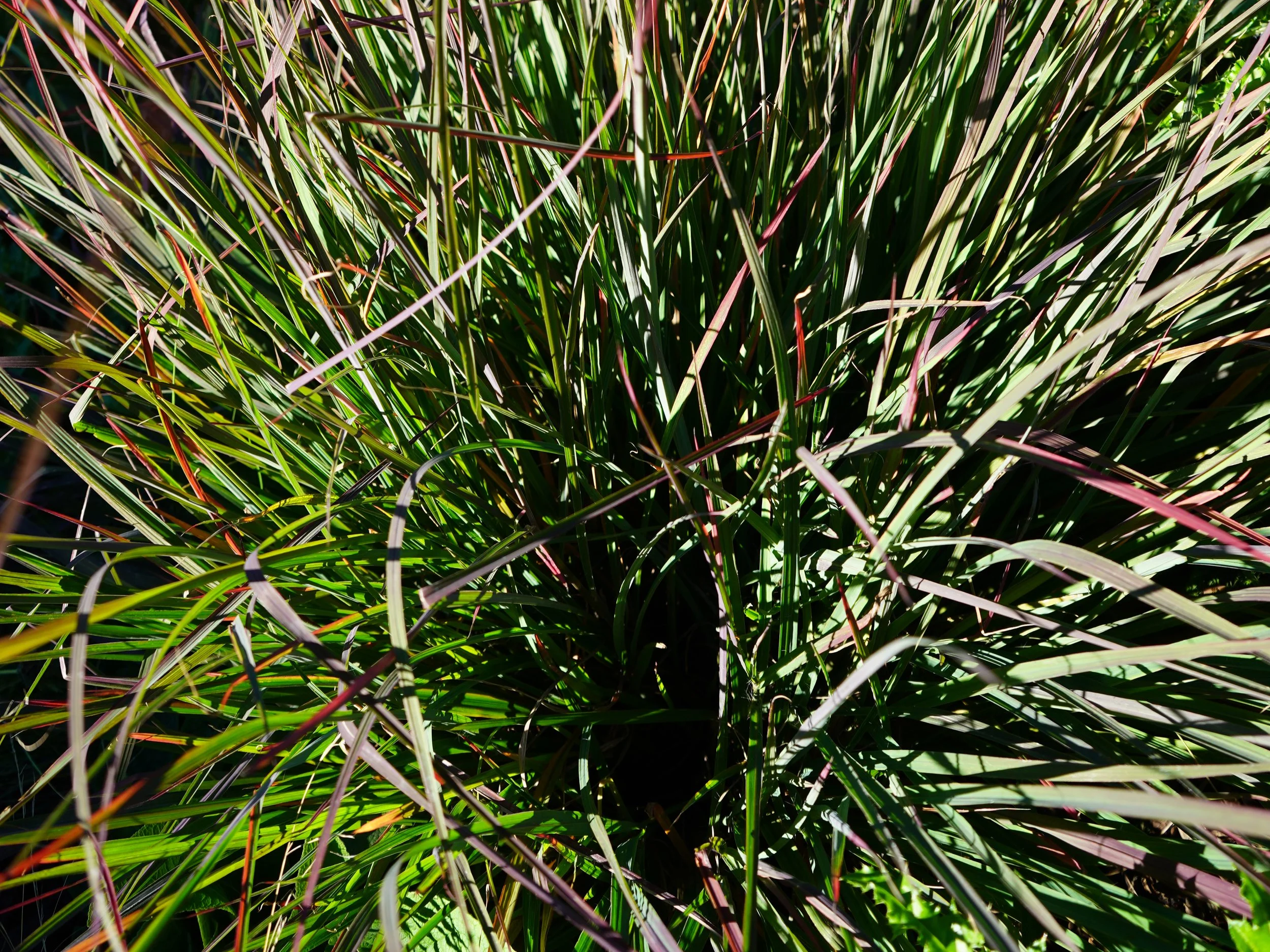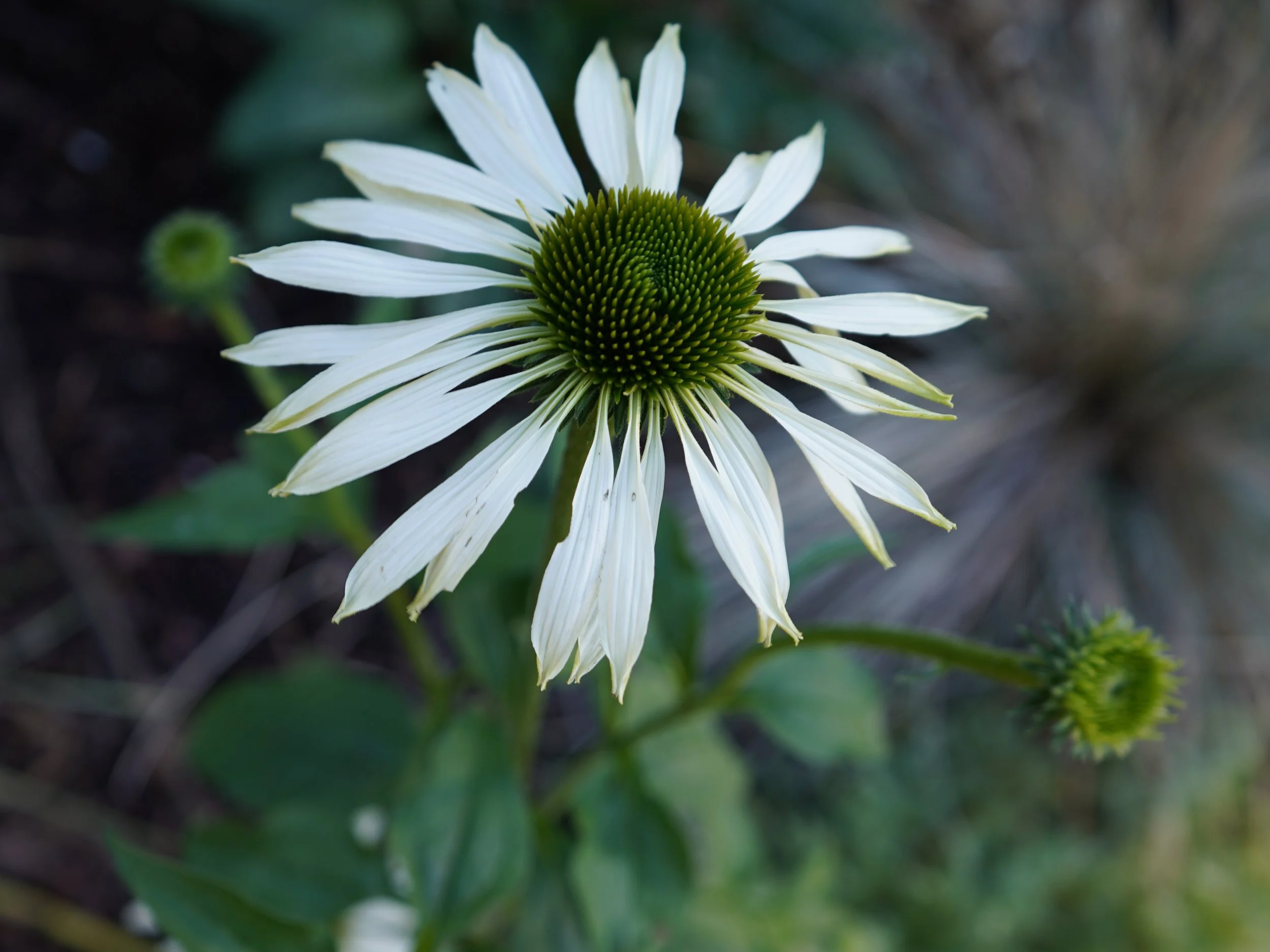SUPPORTING WILDLIFE IN FALL
OCTOBER | 10.21.25
Fall Notes From Brit
I wish you all a smooth slip into fall with a pace and time for reflection that these changing leaf colors showcase as nature prepares for winter. This season of slowing down has me reflecting on something important about how I approach garden design.
One of our guiding principles is to make sure the gardens we design serve the creatures who share them with us. But I'll be honest: this wasn't always my primary lens simply because I didn’t know enough.
Over my 15-year career, there's been a pull towards showy hybrid flowers, valuing beauty and composition over what ecological systems truly desire. And those gardens were beautiful. They brought joy, color, and visual impact that clients loved. But as our business has developed, something deeper has taken root.
At our core, Blueprint Earth exists to serve nature and ecological systems. Without clean natural systems, we humans have nothing: not clean food nor water nor places to engage to find solace and restoration with Earth's best therapist, nature herself. This understanding has become increasingly relevant as I grow into what I call a regenerative beetender (beekeeper feels like a funny word to me, because we're not really keeping them; we're tending to their needs, learning their language).
Here's what I believe about your garden:
These are spaces for you to connect to yourself and each other. I wish to allow people what they value in their gardens, whether that's roses that remind you of your grandmother, dahlias that make your heart sing, or a meditation space surrounded by fragrance. Your garden should bring you joy. That matters.
We will also guide you towards native plants that provide value to pollinators at every opportunity. When we make these choices, the garden comes alive in ways you couldn't have imagined. The hum of bees becomes a soundtrack. The flash of butterflies becomes daily magic. You're not just creating beauty; you're building a sanctuary.
We’ve also updated our buying standards. Beginning this fall, we will no longer purchase plants from nurseries that use neonicotinoids. These systemic pesticides persist in plant tissue, nectar, and pollen, meaning the very plants we buy to "help" pollinators can actually poison them. Neonicotinoids even cause paralysis in bees. It's unconscionable.
That means we purchase from a small, carefully vetted list of nurseries. And you can too. Here's where we source plants that are actually safe for the creatures we're trying to support:
Our Trusted Nursery List (Neonicotinoid-Free):
Xera Plants
Cistus Nursery
Symbiop
Blooming Nursery
Seven Oaks
Sparrow Hawk Native Plants
When you buy from these sources, you're not just getting a plant; you're getting a commitment. A promise that what you're putting in the ground won't harm the very life you're trying to nurture.
yoU CAN DO THIS TOO.
Just by starting with:
One section of your yard where you're willing to experiment
A willingness to ask nurseries, "Do you use neonicotinoids?"
The courage to leave some leaves on the ground in fall
Patience to watch what shows up when you plant even one native
Start small. Plant one Pearly Everlasting. Let one patch of lawn become a meadow. Leave the Echinacea standing through winter instead of cutting it back.
Then watch. Listen. Notice who arrives.
I've dedicated one small section of my garden to cultivars that talk to the past of what I valued and still allow in Blueprint Earth's designs. It's an homage to where I've been: to the beauty we've created over the last 15 years, and a compass pointing to where exactly we're meant to go: toward a greater connection and reality of what nature needs, itself, not our hierarchical way of trying to control it.
In this post, I'm sharing what's blooming in my garden this October: a mix of that journey, from cherished cultivars to native powerhouses, and the vital role each plays in keeping bees, birds, and butterflies fed as they prepare for winter. Consider it a roadmap. An invitation. A challenge, even.
What if your garden could be more than beautiful? What if it could be essential?
Brit’s Fall Garden Blooms
Cosmos atrosanguineus (Chocolate Cosmos)
On the left in the above photo, the velvety, rich, and deeply fragrant, Chocolate Cosmos represent that part of my garden where I still get to play. Their dark red-brown petals radiate warmth in golden hour light.
Pollinator Value: These nectar-rich flowers attract bees, butterflies, moths, and hummingbirds with their abundant nectar and pollen, providing crucial energy when other blooms are fading.
Garden Reality: Tender to our winters (annual). Perfect for adding that chocolate fragrance that makes visitors stop and ask, "Wait, what is that smell?"
Sedum 'Autumn Joy' (Autumn Joy Sedum)
On the right in the above photo, the flower heads shift from pale green to warm pink to rusty bronze. It's one of the last plants in my garden still buzzing with bees this late in the season.
Pollinator Value: This sedum produces lots of nectar at a time of year when other plants do not, attracting honey bees, native bees, bumblebees, wasps, hover flies, and butterflies. The dried flower heads provide winter seeds for birds.
What I've Learned: Cut back in spring, not fall, when new growth begins to emerge. Leaving them standing supports the entire ecosystem through winter.
Anaphalis margaritacea (Pearly Everlasting)
Here's where my garden shifts. Pearly Everlasting is a native wildflower with soft silver tones and papery white blooms. Quiet. Enduring. Exactly what the ghost of summer should look like.
Pollinator Value: This native provides nectar to adult butterflies, bees, and other insect pollinators, and serves as a caterpillar host plant for Painted Lady and American Lady butterflies. Based on Oregon State University field trials, Pearly Everlasting is associated with two species of mining bees and is also commonly visited by the Everlasting Tebenna moth, and sweat bees. For months, even as other flowers fade, Pearly Everlasting remains alive with honeybees, pollinator wasps, syrphid flies, and native bees.
Why This Matters: This is our only true native in today's feature. The difference in pollinator activity is noticeable. Native plants have co-evolved with local insects over millennia. They speak the same language.
Anemone × hybrida 'Whirlwind' (Japanese Anemone)
These semi-double white anemones glow even on gray days. They represent the bridge in my design evolution: not native, but incredibly valuable to pollinators when they need it most.
Pollinator Value: Japanese anemones provide lots of pollen for bees, with both honey bees and bumblebees eagerly visiting the flowers. Bumblebees especially favor Japanese anemones, employing "buzz pollination" techniques to help loosen pollen from the plants' tightly constructed anthers. The open flower structure provides comfortable landing spots for various bee species and hover flies.
The Balance: Not every plant in a regenerative garden needs to be native, but every plant should earn its place by serving the ecosystem.
Schizachyrium scoparium 'The Blues' (Little Bluestem)
Little Bluestem grass is the backbone of my fall garden. Its silvery-blue blades shift into rose, copper, and violet as the weather cools, catching the light like spun glass.
Wildlife Value: Little Bluestem provides cover for ground birds and small mammals, and the seed is eaten by songbirds and upland gamebirds. The clump-type growth habit provides excellent nesting sites, and seeds are consumed by rosy finches, juncos, chipping sparrows, field sparrows, and tree sparrows. It serves as a host plant for skipper butterfly caterpillars, provides nesting material for native bees, and supports grasshoppers, beetles, and leafhoppers that feed insectivorous songbirds.
What I Know Now: Leave it standing through winter. It's beautiful under frost, but more importantly, it's functional. Grasses are infrastructure for the entire food web.
Echinacea purpurea 'White Swan' (White Swan Coneflower)
White Swan Coneflower is a Blueprint Earth mascot. When goldfinches visit daily, you know the garden still has plenty to offer.
Pollinator Value: Although we love this white cultivar. The true value lands with the Midwest, Eastern and Southern American native, Echinacea purpurea. Coneflowers are nectar-rich and highly attractive to honey bees, native bees, leafcutter bees, bumblebees, butterflies (including monarchs, tiger swallowtails, skippers, American ladies, and red admirals), and ruby-throated hummingbirds. Purple coneflower blooms during the summer dearth when there are often fewer flowers blooming that honey bees will use. Echinacea purpurea is a host plant for the caterpillars of the silvery checkerspot butterfly. Once flowers go to seed, goldfinches, sparrows, and chickadees devour the seeds.
The Truth: Leave the dried seed heads standing through winter. Choose single-flowered varieties, not double-flowered "pom-poms" that hide nectar and pollen.
Why Late-Season Nectar Is Life or Death
As temperatures drop, bees face a critical window. Honeybees need to store enough food to sustain the hive through winter. Bumblebee queens need to build fat reserves before going underground. Native solitary bees are sealing up nests with provisions for next year's generation.
The equation is urgent: Each flower provides essential carbohydrates from nectar and proteins from pollen. Without these late bloomers, colonies weaken, queens fail to overwinter, native bee populations decline.
The plants blooming in October aren't decorative; they're lifelines.
What Each Plant Actually Does
For Honeybees and Bumblebees:
Sedum 'Autumn Joy' and Echinacea provide nectar when little else is available
Japanese Anemone offers abundant pollen that bumblebees harvest through buzz pollination
For Native Bees:
Pearly Everlasting supports specialist mining bees and sweat bees
Little Bluestem provides nesting material and structural habitat
For Butterflies and Moths:
Pearly Everlasting hosts American Lady and Painted Lady butterfly caterpillars
Little Bluestem hosts skipper butterfly species
Chocolate Cosmos, Japanese Anemone, and Echinacea provide nectar
For Birds:
Echinacea seed heads feed goldfinches, sparrows, and chickadees through winter
Little Bluestem seeds sustain songbirds
Little Bluestem's clumping structure creates nesting sites and cover
We're not decorating; we're building habitat.
BONUS: More Natives To Drool Over
Solidago occidentalis (Western Goldenrod)
Bright golden-yellow clusters that light up the late summer through fall garden. This is native gold, literally and ecologically.
Pollinator Value: Rich in nectar and pollen during fall when pollinator food is scarce. The tall inflorescences create landing platforms for larger bees and butterflies, while honeybees, bumblebees, and hoverflies work the blooms methodically. Provides seeds for birds and cover for small insects through winter.
Growing Reality: Tolerates a range of soils and light conditions. Plant in mixed borders or meadow-style gardens where it can shine without apology.
Symphyotrichum subspicatum (Douglas Aster)
Purple daisy-like blooms with yellow centers that persist from late summer through fall. When most gardens have gone quiet, this native aster is still feeding life.
Pollinator Value: Provides nectar and pollen late in the season, critical when many other plants have stopped blooming. Supports native mason bees, sweat bees, butterflies, and hoverflies. Dense clumps offer shelter for small insects and overwintering pollinators. Flowers attract predatory insects like ladybugs, which help control garden pests naturally.
Growing Reality: Tolerates partial sun to full sun and prefers moist but well-drained soil. Works beautifully in naturalized meadows or woodland edges where it can spread and support the ecosystem.
Mahonia aquifolium (Oregon Grape)
Blue-purple berries ripen in late fall, offering sustenance when winter food becomes scarce. This evergreen native is a year-round workhorse.
Wildlife Value: Berries feed robins, thrushes, cedar waxwings, and mockingbirds, persisting into winter for prolonged food supply. Evergreen foliage provides essential winter cover and shelter when deciduous plants have dropped their leaves.
Growing Reality: Thrives in shade to part sun. Tough, drought-tolerant once established, and looks good doing the work.
Symphoricarpos albus (Snowberry)
White berries emerge in late fall and persist into early winter, like small luminous ornaments when the garden has gone dormant. This native shrub feeds and shelters.
Wildlife Value: Berries sustain thrushes, waxwings, grosbeaks, and sparrows through the lean months. Dense shrub structure offers excellent shelter and nesting habitat, creating safe spaces for birds year-round.
Growing Reality: Adaptable to sun or shade. Spreads to form thickets, which is exactly what wildlife needs. Let it do its thing.
Where We're All Headed
This shift (from ornamental to ecological, from control to collaboration) is where landscape design needs to go. Not abandoning beauty, but understanding that true beauty includes function. Includes life. Includes the hum of bees in October when most gardens have gone quiet.
You don't have to be perfect. You just have to start.
Start with one native plant. One section of leaves left on the ground. One nursery where you ask, "Do you use neonicotinoids?" One choice to leave the seed heads standing.
One choice becomes a pattern. A pattern becomes a garden. A garden becomes habitat.
Your garden can be part of the solution. What are you going to plant?
Need Help Designing and Building Your Dream Garden?
If you’re ready to create a garden but want an expert team to handle the details, Blueprint Earth is here to help. We specialize in evaluating landscapes, planning for stormwater and grading, and designing sustainable gardens that thrive in the Pacific Northwest.
Let us bring your vision to life—contact Blueprint Earth today to get started!

